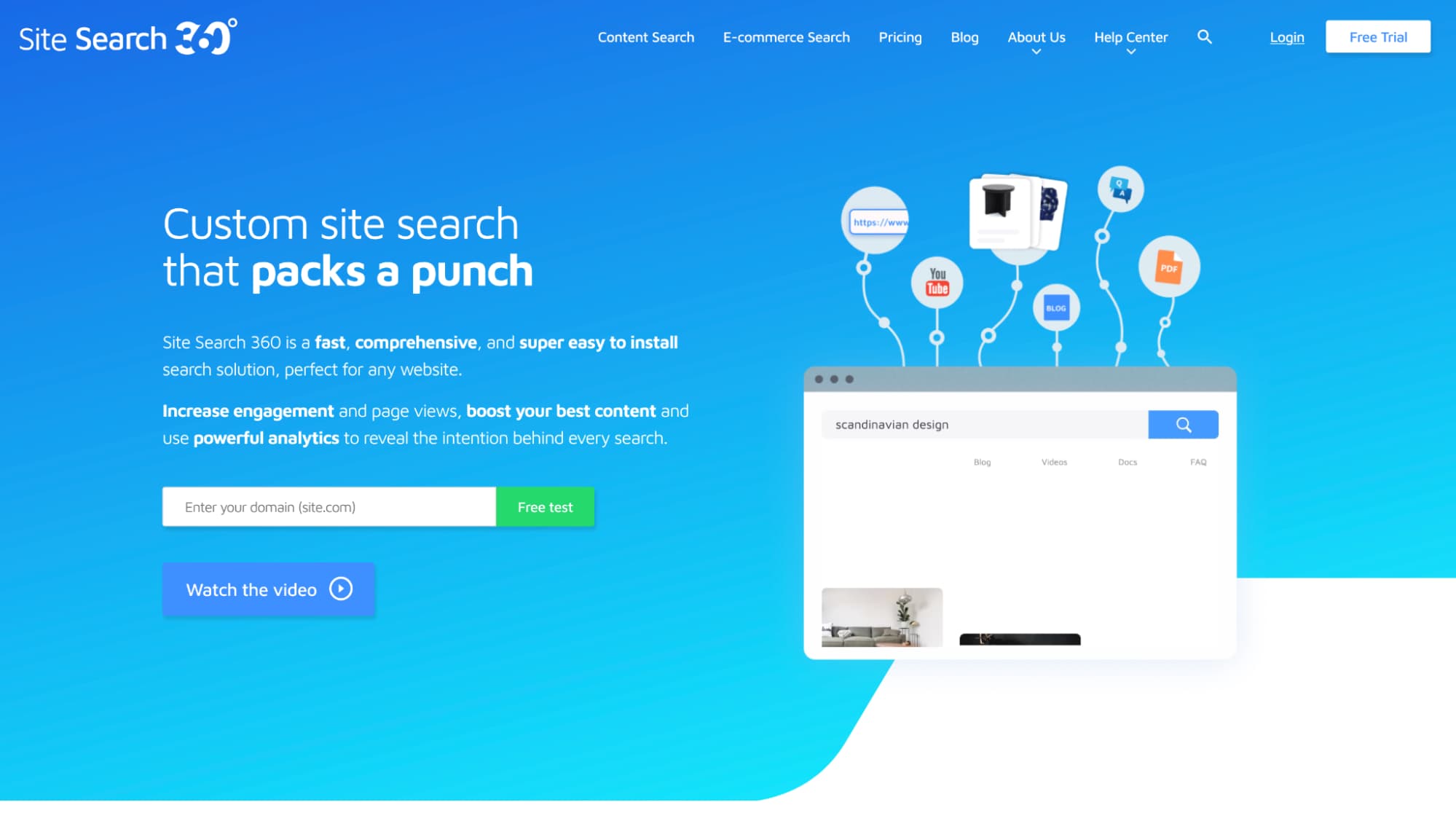Finding information on your website shouldn't feel like searching for a needle in a haystack. Yet for many brands that's exactly what their visitors experience every day, with some immediately leaving to a competitor’s site.
The good news? Site search software helps businesses prevent that. Site search solutions deliver search experiences that combine AI with the latest search technologies to anticipate user needs, improve engagement, and increase conversions and sales.
In this guide, we present some of the top site search solutions in the market to consider based on use case and needs.
In this guide, we will cover:
Why better site search matters (and how tools support it)
Site search is no longer a keyword-based, “nice-to-have” feature — it’s a core, powerful part of how users navigate your site, with almost half of visitors going straight to a site’s search bar. Site visitors who search are 2-3x likelier to convert than non-searchers, and are responsible for almost half of ecommerce revenue. Site search is not just for ecommerce. Many other use cases benefit from making content accessible.
Here’s why site search matters more than ever and how the right tools support it:
User expectations have changed
Search = conversion
-
Search users are often the most intent-driven—whether they’re looking for a product, solution, or specific content. Optimized search directly influences your conversion rate.
-
AI-powered site search tools help surface the right result faster, improving discovery, engagement, and revenue.
Content & product volume is exploding
-
With thousands of SKUs, blog posts, help docs, or product features, websites have outgrown basic search.
-
Modern tools use real-time indexing, dynamic filtering, and semantic understanding to help users find what they want—fast.
Search as a differentiator and BI tool
-
Best-in-class brands are using site search to deliver better experiences than competitors, capture zero-party data, and reveal customer preferences, content gaps, and emerging trends through query analysis.
-
The right site search software helps brands turn search into a business intelligence tool to help not just improve search but inform merchandising, UX, and content strategy.
AI and LLMs are reshaping search
-
The shift toward AI, semantic search, and large language models enables site search to go beyond keywords.
-
Modern platforms are leveraging the latest AI and search technology to understand intent and context, offer more personalized results faster, all while keeping you ahead of the curve as user behavior evolves.
For businesses across many industries, site search and leveraging solutions to improve it has become a key component in customer experience and retention, audience growth, competitive differentiation, brand experience, and revenue.
Overview of today’s top site search tools
Here's an overview of some of the leading site search tools on the market today and how they compare across key evaluation criteria:
|
Vendor
|
Best For
|
Pricing Model
|
Key Strengths
|
Deployment Options
|
Notable Limitations
|
|
Algolia
|
Mid-market to enterprise businesses, including ecommerce, needing scalable, AI-powered search
|
Usage-based + enterprise
|
Lightning-fast performance, extensive API ecosystem, advanced AI technology
|
Cloud SaaS, API-first
|
B2B features less developed than B2C
|
|
AddSearch
|
SMBs to enterprises wanting easy implementation
|
Tiered plans + enterprise
|
No-code setup, personalization features, strong customer support
|
Cloud SaaS, JavaScript widget
|
Limited free tier, pricing can be high for smaller businesses
|
|
Swiftype, an Elastic company
|
Organizations already using Elastic or needing enterprise features
|
Tiered plans + enterprise
|
Powerful crawling, drag-and-drop customization, Elastic ecosystem
|
Cloud SaaS, on-premise available
|
Learning curve for advanced features, can be costly for high volume
|
|
Site Search 360
|
Businesses transitioning from Google Site Search
|
Tiered plans
|
Semantic search in 19 languages, extensive customization
|
Cloud SaaS, JavaScript implementation
|
Learning curve for advanced features, performance considerations at scale
|
|
Bloomreach
|
Large ecommerce operations
|
Enterprise
|
Comprehensive commerce suite, AI personalization
|
Cloud SaaS, headless
|
Complex implementation, high cost, requires technical resources
|
|
Fast Simon
|
Ecommerce businesses on Shopify/BigCommerce
|
Tiered plans + enterprise
|
No-code editor, visual discovery, B2B features
|
Cloud SaaS, platform apps
|
Can be expensive for features, implementation complexity varies
|
|
Searchspring
|
Mid-market retailers
|
Tiered plans
|
Strong merchandising tools, extensive integrations
|
Cloud SaaS
|
Steep learning curve, higher entry price point
|
|
Sitecore Search
|
Enterprises using SiteCore CMS
|
Enterprise
|
Headless architecture, AI-driven personalization
|
Cloud SaaS, API-first
|
Complex implementation, significant investment required
|
|
Meilisearch
|
Small to midsize sites and applications
|
Tiered and enterprise plans
|
Lightweight, fast, and easy to set up open source solution
|
Options for self-hosted or managed cloud hosting
|
Limited scalability and small ecosystem of plugins and integrations
|
|
Coveo
|
Enterprises with technical resources and complex needs
|
Pro and enterprise plans
|
Capable for both customer-facing and internal search experiences
|
Cloud SaaS
|
Requires technical resources for setup and maintenance
|
|
Elasticsearch
|
Organizations that prioritize full control, customization, and scalability
|
Tiered, usage-based plans
|
Robust ecosystem of tools, powerful analytics
|
Cloud-hosted (Elastic Cloud) or self-managed
|
Lacks native ecommerce search features, setup and maintenance are complex
|
| |
|
|
|
|
|
Best site search software, evaluated
Algolia

Overview: With more than 18,000 customers globally, Algolia has established itself as a market leader in AI-powered search, leading the pack in the latest Gartner Magic Quadrant on Search and Product Discovery, and known for its speed, reliability, and scalability.
Algolia offers robust analytics, business-friendly merchandising controls, and extensive integrations with platforms like Shopify, Magento, and Salesforce Commerce Cloud — making it a top choice for brands seeking scalable, customizable search experiences. Algolia DocSearch is a free solution for adding AI-powered search to technical documentation.
Pros:
-
Industry-leading speed with response times of 1-20 milliseconds ensures instant search results that keep users engaged
-
Comprehensive API ecosystem and SDKs for all major programming languages enable flexible, custom implementations
-
NeuralSearch technology combines keyword and vector search for superior relevance, understanding context beyond literal matches
-
Generous free tier (10,000 searches/month) allows thorough testing before commitment
Cons:
-
Requires technical resources for initial setup, but offers no-code tools for ongoing configuration
-
B2B-specific features like account-based search lag behind B2C capabilities
-
Advanced customization or unique use cases may require developer resources
Best for: Growing businesses and enterprises that need reliable, scalable search with strong developer tools and premium performance.
AddSearch

Overview: Helsinki-based AddSearch serves nearly 2,000 global customers across media, government, education, and ecommerce sectors. Following its 2023 acquisition by saas.group, the platform continues to focus on delivering enterprise-grade search with exceptional ease of implementation.
Pros:
-
Implementation requires only a simple JavaScript snippet, enabling deployment within minutes
-
Built-in personalization tailors results based on user behavior without complex configuration
-
Customer support consistently receives praise for responsiveness and expertise
-
PDF indexing and cross-domain search capabilities address complex content needs
Cons:
-
Professional tier at $129/month may be steep for small businesses with limited budgets
-
Some advanced features require technical knowledge despite "no-code" positioning
-
Limited free tier compared to competitors
Best for: Organizations seeking a balance between sophisticated features and implementation simplicity, particularly those with diverse content types.
Swiftype

Overview: Acquired by Elastic in 2017, Swiftype leverages Elasticsearch technology to provide hosted search solutions for over 900 brands including AT&T, Samsung, and HubSpot. The platform offers both Site Search and Enterprise Search products.
Pros:
-
Intelligent crawler automatically indexes content without manual configuration
-
Drag-and-drop result customization empowers non-technical users to optimize search
-
Deep integration with Elastic ecosystem provides additional capabilities
-
Transparent pricing starting at $79/month makes budgeting predictable
Cons:
-
Volume-based pricing can become expensive for content-heavy sites
-
Some users report a learning curve for maximizing platform capabilities
-
Limited front-end customization compared to API-first alternatives
Best for: Organizations wanting enterprise-grade search without infrastructure management, especially those already using Elastic products.
Site Search 360

Overview: Based in Dresden, Germany, Site Search 360 emerged as a strong alternative when Google discontinued its Site Search service. The platform combines semantic search capabilities with extensive customization options.
Pros:
-
Semantic search in 19 languages with built-in dictionaries provides instant multilingual capability
-
Free forever plan makes it accessible for small sites and testing
-
Query mapping allows precise control over search results for specific terms
-
Comprehensive customization through Search Designer tool
Cons:
-
Advanced features have a steep learning curve requiring time investment
-
Some users report performance considerations with very large catalogs
-
Geographic concentration in English-speaking markets may limit international support
Best for: Businesses transitioning from Google Site Search or needing strong multilingual support with visual customization capabilities.
Bloomreach

Overview: Bloomreach Discovery is part of a comprehensive Commerce Experience Cloud serving over 1,400 brands. The platform leverages 14+ years of ecommerce data to deliver AI-powered search and merchandising.
Pros:
-
Loomi AI provides sophisticated personalization based on extensive ecommerce dataset
-
Comprehensive platform includes search, merchandising, and content management
-
Visual search capabilities for fashion and visual product categories
-
Strong performance with proven enterprise scalability
Cons:
-
Complex implementation often requires 6-8 weeks for mid-market deployments
-
Pricing lacks transparency with custom quotes required
-
May be overkill for businesses with simple search needs
Best for: Large ecommerce operations needing comprehensive personalization and merchandising capabilities with dedicated technical resources.
Fast Simon

Overview: This Silicon Valley-based company serves over 600 million shoppers monthly across thousands of brands, focusing on AI-powered ecommerce optimization with integrated search and merchandising.
Pros:
-
No-code editor enables non-technical users to implement sophisticated optimizations
-
Strong Shopify integration with verified partner status since 2013
-
Visual discovery and image optimization features enhance product discovery
-
B2B-specific features address wholesale and business customer needs
Cons:
-
Pricing perceived as expensive relative to some competitors
-
Enterprise implementations can extend 6-18 months
-
Session-based pricing model may concern rapidly growing businesses
Best for: ecommerce businesses on Shopify or BigCommerce seeking integrated AI-powered search and merchandising.
Searchspring

Overview: With over 15 years in the market, Searchspring serves 2,000+ brands globally and holds leader status in multiple G2 categories for ecommerce search and personalization software.
Pros:
-
IntelliSuggest behavioral optimization automatically improves results based on user actions
-
Extensive integration ecosystem with 1,500+ supported channels
-
Strong merchandising tools with visual interfaces
-
Proven ROI with documented conversion improvements
Cons:
-
Consistent feedback about steep learning curve for full platform utilization
-
Starting price of $699/month may exclude smaller businesses
-
Some users report slower support response during peak periods
Best for: Mid-market to enterprise retailers with dedicated resources for ongoing optimization and merchandising.
Sitecore Search

Overview: Built on Sitecore's 2021 acquisition of Reflektion, this headless content discovery platform integrates AI and machine learning for personalized search experiences across digital properties.
Pros:
-
Headless architecture provides maximum flexibility for custom implementations
-
Questions and Answers feature enables conversational search interactions
-
Deep integration with Sitecore ecosystem for existing customers
-
Real-time behavioral analysis adapts results dynamically
Cons:
-
Enterprise pricing typically ranges $40,000-$200,000 annually
-
Complex implementation requires significant technical expertise
-
May be excessive for organizations with basic search needs
Best for: Large enterprises with complex content ecosystems requiring sophisticated personalization and already invested in Sitecore technologies.
Meilisearch

Overview: Meilisearch is an open-source, developer‑friendly, fast site search engine built in Rust, delivering instant autocomplete, typo tolerance, and semantic relevance with minimal configuration and seamless integration via a RESTful API.
Pros:
-
Extremely fast, near-instant search-as-you-type experience.
-
Built-in typo tolerance and smart autocomplete for improved user experience.
-
Lightweight and easy to set up, ideal for developers.
-
Advanced features out of the box: filtering, facets, customizable ranking, and semantic search.
Cons:
-
Performance may degrade on very large datasets compared to more scalable engines.
-
Limited distributed cluster capabilities and enterprise-level scalability.
-
Smaller ecosystem compared to mature search stacks; fewer plugins and integrations out of the box.
Best for: Small to mid‑sized applications like blogs, content platforms, or lightweight ecommerce stores where quick implementation, developer control, and fast search experience are priorities, without needing extensive enterprise infrastructure.
Coveo

Overview: Coveo is an AI-powered enterprise search and relevance platform delivering powerful site search, personalization, and analytics capabilities across customer-facing websites, support portals, and internal knowledge bases.
Pros:
-
Highly capable of delivering personalized, AI-driven search experiences and commerce relevance.
-
Designed for internal and external search use—supports knowledgebases, intranets, and support workflows.
-
Intuitive UI for managing search relevance and personalization—favored by business users.
-
Strong enterprise-grade AI and machine learning capabilities for intelligent recommendations and search tuning.
Cons:
-
Complex to configure, and optimizing requires substantial setup time and technical expertise.
-
Enterprise pricing can be limiting for smaller teams or projects.
-
Steep learning curve for new users, especially when handling advanced features.
Best for: Mid‑to‑large enterprises with technical and budget resources that are looking for an AI-enhanced search solution for either customer-facing sites or internal knowledge workflows.
Elasticsearch

Overview: Elasticsearch is a popular, distributed, open-source search and analytics engine built on Lucene, offering robust full-text search, real-time indexing, rich query DSL, and a powerful ecosystem.
Pros:
-
Scalable and distributed architecture for large datasets and high query volumes.
-
Real-time search and analytics capabilities via a flexible JSON-based REST API.
-
Highly flexible query language supports full-text, faceting, aggregations, filters, and custom relevance.
-
Rich ecosystem (Elastic Stack) with tools like Kibana, Logstash, and wide language support.
Cons:
-
Steep learning curve, with complex index design, configuration, and cluster management requirements.
-
Not a turnkey site search solution, and can require substantial development to build UI and relevance layers
-
Total cost of ownership can grow quickly: includes infrastructure, engineering hours, hosting, and maintenance
Best for: Large-scale, technical organizations with strong engineering resources that need a highly customizable, scalable search and analytics backend.
Key features to look for in site search software
Brands should look for site search solutions that deliver key features and capabilities like the following:
-
Autocomplete & typo tolerance
-
Semantic intent understanding
-
Faceted filtering
-
AI-powered personalization & recommendations
-
Analytics
-
Mobile-first, customizable UI
-
Scalability & multilingual support
Choosing a site search solution with smart autocomplete, semantic relevance, AI personalization, robust analytics, and a mobile-first, customizable UI means equipping your brand to understand user intent and drive conversions.
This helps make the search experience not just functional but transformational and impactful.
Key features, explained:
AI and intelligent search
Why it matters: Using AI and combination of search technologies that allow for intelligent search are vital for site search software. They’re able to go beyond basic keyword matching, and can interpret user intent, personalize results in real time, and continuously refine relevance in order to deliver accurate, context-aware experiences that drive engagement and conversions.
What to look for:
-
Semantic, vector, and hybrid search capabilities that go beyond keyword search to understand context and meaning
-
Synonym recognition and automatic query expansion
-
Support for conversational, long-tail queries that reflect how people naturally express their needs
-
Ability to handle industry-specific terminology and jargon
-
Multilingual search capabilities that are language-agnostic
Personalization and behavioral learning
Why it matters: Personalized search can deliver up to 50% higher conversion rates, improve retention, and drive better engagement. Plus, most customers today expect not just personalized, but hyper-personalized experiences with a brand. AI-powered personalization analyzes browsing history, purchase patterns, and real-time behavior to deliver increasingly relevant search results for each user.
What to look for:
-
Real-time result adaptation based on user behavior during the current session
-
Historical preference learning that improves results over time
-
Ability to personalize for both logged-in users and anonymous visitors
-
Integration with customer data platforms for comprehensive personalization
Speed, scalability, and performance
Why it matters: Search results must feel instantaneous. Even 100-millisecond delays can impact user satisfaction and conversion rates. With more than half of ecommerce shopping occurring on mobile devices, mobile optimization is non-negotiable.
What to look for:
-
Sub-100ms query response times, even during peak traffic
-
Global CDN infrastructure for consistent performance worldwide
-
Automatic scaling for traffic spikes and seasonal peaks
-
Mobile-optimized interfaces with appropriate touch targets and responsive design
Analytics and business intelligence
Why it matters: Search analytics aren’t just a nice-to-have feature — they’re a BI tool. This data can reveal what customers want, what they can't find, and how they describe products in their own words. Site search analytics can be leveraged to not just improve the search experience, but inform merchandising strategies, content, and UX.
What to look for:
-
Real-time dashboards showing search performance metrics
-
Query analysis revealing popular searches and content gaps
-
Conversion tracking linking search behavior to business outcomes
-
Zero-results tracking to identify missing content or products
-
Integration with existing analytics platforms like Google Analytics
Merchandising and business control
Why it matters: Non-technical teams need the ability to optimize search results without developer involvement. This agility enables rapid response to inventory changes, promotional campaigns, and market trends.
What to look for:
-
Visual merchandising tools with drag-and-drop interfaces
-
Rule-based product boosting and demotion capabilities
-
A/B testing functionality for search optimization
-
Faceted navigation allowing users to filter by multiple attributes simultaneously
-
Ability to create custom landing pages and search experiences
How to choose the right site search tool
Selecting the optimal site search solution requires careful and step-by-step evaluation of your specific needs, resources, and growth trajectory. Here's a practical framework to guide your decision:
Step 1: assess your current state
Start by evaluating your existing search performance and identifying pain points:
-
Measure current search-to-conversion rates and compare them to site averages
-
Track zero-result queries to understand what users can't find
-
Analyze search abandonment rates and user feedback about search experiences
-
Document technical limitations of your current solution
Step 2: define requirements and priorities
Map your specific needs across key dimensions:
-
Data size and complexity: Solutions scale differently from hundreds to millions of items
-
Use case and application: Some software is best for certain use cases and industries, whether an ecommerce storefront, SaaS platform, or content publisher.
-
Traffic volume: Ensure the platform can handle current and projected search volumes
-
Technical resources: Assess whether you need no-code tools or have developers available
-
Budget constraints: Consider both initial costs and ongoing operational expenses
-
Integration needs: List critical systems that must connect with search (CMS, CRM, analytics)
Step 3: Shortlist and evaluate vendors
Create a shortlist of 3-5 vendors that align with your requirements:
-
Request tailored demos focused on your specific use cases, not generic presentations
-
Ask for customer references in similar industries or with comparable needs
-
Evaluate total cost of ownership including implementation, training, and ongoing optimization
-
Test the quality of documentation and support resources
Step 4: Pilot, trial, and validate
Before committing to a full implementation:
-
Run proof-of-concept projects with real data and traffic when possible
-
Start with a free trial to get an understanding of how the software functions
-
Measure performance against your specific success criteria
-
Involve key stakeholders including IT, marketing, and customer service teams
-
Document any gaps or concerns that emerge during testing
Step 5: Plan for success
Ensure successful implementation and adoption:
-
Allocate sufficient resources for initial setup and ongoing optimization
-
Establish clear success metrics and monitoring processes
-
Plan for team training and change management
-
Create optimization roadmaps for continuous improvement
Measuring ROI and success
Implementing site search software is a significant investment that when done properly delivers measurable returns. Here's how to track and optimize your investment:
Key performance indicators
To measure the effectiveness of your site search implementation, track and measure search quality metrics and business impact metrics. Each offers insight into how well your search experience serves users and drives business outcomes.
Search Quality Metrics:
-
Click-through rate from search: Indicates result relevance and user satisfaction
-
Search refinement rate: High rates suggest initial results aren't meeting user needs
-
Zero-results rate: Track reduction as a measure of improved content coverage
-
Search exit rate: Users leaving after searching indicates poor result quality
Business Impact Metrics:
-
Search-driven conversion rate: Primary ROI indicator comparing searchers to non-searchers
-
Average order value from search: Typically higher for search users, indicating qualified intent
-
Revenue per search visitor: Direct correlation between search quality and revenue generation
-
Customer lifetime value: Search users often demonstrate higher retention and repeat purchase rates
ROI calculation framework
Calculate return on investment using this formula: ROI = (Incremental Revenue - Total Investment) / Total Investment × 100
For example: If implementing advanced search increases monthly revenue by $50,000 against a $10,000 monthly investment (licensing + resources), your ROI is 400%.
Expected timeline for results
Most organizations see measurable improvements following this pattern:
-
Weeks 1-4: Initial improvements in search speed and basic relevance
-
Months 2-3: Noticeable increases in click-through rates and user engagement
-
Months 3-6: Significant conversion rate improvements and revenue impact
-
Months 6+: Continuous optimization drives compound improvements
Organizations typically achieve clear ROI within 3-6 months, with many seeing immediate improvements in user engagement metrics.
Report: Algolia commissioned Forrester Consulting to conduct a Total Economic Impact (TEI) study and examine the potential return on investment (ROI) enterprises may realize by deploying its Search and Discovery platform. Download the report.
Site search software as a growth driver
Site search has evolved from a nice-to-have feature to a critical business driver impacting revenue, customer satisfaction, and competitive advantage.
Success depends on choosing a solution aligned with your specific needs, resources, and growth trajectory. The market offers options for businesses of all sizes and needs, and the right platform can transform site search from a basic utility into a powerful business growth driver.
If you’re interested in learning more about how Algolia can help your brand deliver faster, more relevant, and personalized search experiences for your customers and visitors, speak with one of our experts and get started with a demo.
FAQ
What is site search software and how does it differ from a standard website search bar?
Site search software provides more powerful and customizable search functionality than basic built-in search bars. It typically includes features like relevance tuning, typo correction, AI-powered personalization, real-time analytics, and advanced filtering options.
How does site search work?
Site search software indexes your website content—such as product pages, blog posts, and help docs—then uses algorithms to return the most relevant results when a user performs a search. Advanced tools enhance this with natural language processing (NLP), behavioral learning, and semantic understanding to interpret intent and deliver smarter, more personalized results.
Why is site search important for user experience and conversions?
Visitors who use site search often have high intent. A fast, intuitive, and relevant search experience helps them find what they need quickly, reducing frustration and increasing the likelihood they’ll convert—whether that means making a purchase, booking a demo, or reading more content.
What features should I look for in modern site search software?
Key features include semantic search and NLP, autocomplete suggestions, typo tolerance, synonym recognition, faceted filtering, AI-driven personalization, search analytics, and zero-results tracking.
How does AI improve site search performance?
AI enhances search by interpreting user intent, adapting results in real time based on behavior, and personalizing the experience for each visitor. It also helps optimize rankings based on conversion goals and continuously learns from new data.
What’s the difference between semantic search and keyword-based search?
Keyword search matches exact terms in content, while semantic search uses AI and NLP to understand the meaning behind queries—even if the exact words aren’t present—returning more contextually relevant results.
Is site search only useful for ecommerce sites?
Not at all. While ecommerce is a major use case, site search also benefits SaaS platforms, content-heavy blogs, documentation portals, internal knowledge bases, educational sites, and customer support centers.
What kind of analytics should a good site search tool offer?
Look for tools that show popular searches, zero-result queries, click-through rates, search refinements, and conversion tracking. Integration with platforms like Google Analytics or your CDP is also useful for deeper insights.
Can site search tools index dynamic or non-text content?
Yes. Many modern tools can index JavaScript-rendered content, PDFs, videos, structured data, and even content from external domains or headless CMS platforms.
How long does implementation usually take, and does it require developer support?
It depends. Some platforms offer no-code or low-code options (like plug-and-play scripts or plugins), while others require API integration, particularly for custom stacks or headless setups.
AI Search
Les résultats que les utilisateurs veulent voirAI Browse
Pages de catégories et de collections construites par l'IAAI Recommendations
Suggestions à tout moment du parcours utilisateurMerchandising Studio
Expériences client améliorées grâce aux données, sans codeMerchandising Studio
Expériences client améliorées grâce aux données, sans codeAnalytics
Toutes vos informations dans un seul tableau de bordComposants UI
Composants pré-construits pour des parcours personnalisés















